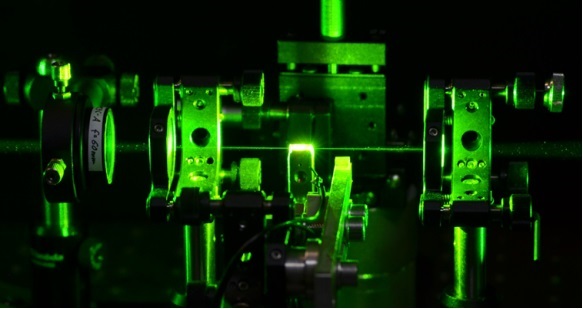3 AUGUST 2016
A study by Macquarie University researchers has found a new way to make ultra-pure frequency lasers based on diamond that avoids the problems responsible for destabilising and broadening a laser’s frequency.
The results, published in the Optical Society of America journal Optica, are hoped to enable the next generation of lasers required for remote sensing of greenhouse gases, atomic clocks and atom trapping, as well as in gravitational wave astronomy.
Using diamond, Dr Oliver Lux and Associate Professor Rich Mildren from the Department of Physics and Astronomy demonstrated stable single frequency operation using a simple laser cavity design that would normally be highly susceptible to destabilisation. In particular, they placed the diamond at the midpoint of a long standing wave cavity, a configuration normally considered a ‘worst-case scenario’ for inducing the instabilities that cause polychromatic behaviour to occur.
“Lasers are often thought of as being highly monochromatic, that is, of a single frequency, but in most cases their spectral purity is corrupted by a destabilising effect referred to as spatial-hole burning. This effect causes the laser frequency to chaotically jump between a grouping of many closely spaced lines,” said Associate Professor Mildren.
“The problem is avoided in our case by using a light amplifying medium that relies on stimulated scattering rather than an excited medium that contains energy such as a population inversion.”
Many laser applications require a pure frequency – a need made even more relevant by the current explosion in interest in gravitational wave astronomy, which relies on interference of single frequency laser beams that are high power and ultra-stable.
“Our finding provides greater freedoms for laser design and potentially much simpler, more robust systems. And, since the light amplifier ‘engine’ works using a fundamentally different principle to most lasers we are familiar with, a completely different range of materials may be used including those with extraordinary properties such as diamond. This promises a method of generating single frequency lasers over a wider choice of wavelengths and with potentially very high power.”
O. Lux, S. Sarang, O. Kitzler, D.J. Spence, and R.P. Mildren Intrinsically stable high-power single-longitudinal-mode laser using spatial hole burning free gain. Optica, vol. 3. No. 8 (2016).












